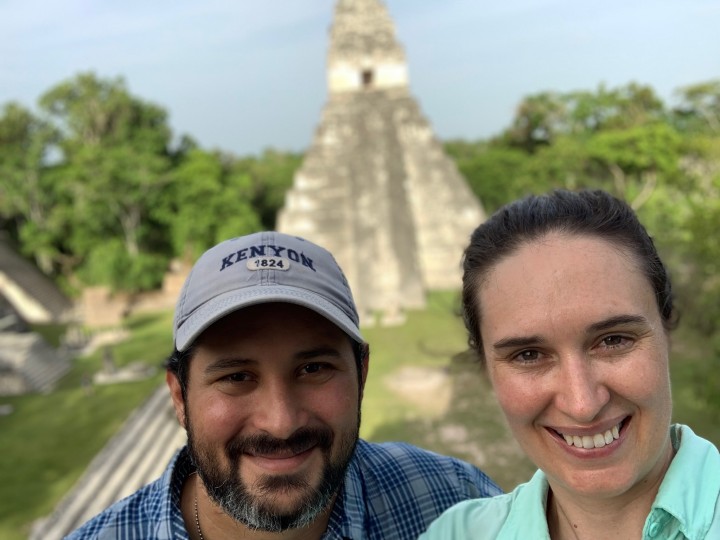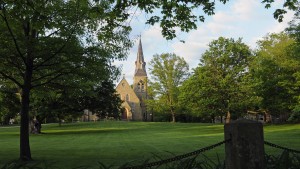Two anthropology professors hope an archaeological excavation on campus this semester will unearth important details from Kenyon’s distant past.
The possibilities of what they and their students might find near the Church of the Holy Spirit include everything but the kitchen sink. Actually, maybe that, too, since the site is believed to be the location of the college’s first dining hall about 200 years ago.
 “We’re hoping that this will tell us a lot about what daily life was like, what student life was like, what people were eating,” said Claire Novotny, associate professor of anthropology. “It just seems like a pretty rich spot for learning about what life was like at the very beginning of the College.”
“We’re hoping that this will tell us a lot about what daily life was like, what student life was like, what people were eating,” said Claire Novotny, associate professor of anthropology. “It just seems like a pretty rich spot for learning about what life was like at the very beginning of the College.”
She and Tómas Gallareta Cervera, assistant professor of anthropology and Latino/a Studies, expect to begin the dig on Friday, Sept. 8, as part of an archaeological methods course (Anthropology 491).
Every Friday through the end of October, about a dozen students will work on excavating the lawn in front of the church, which will be set off by fencing. They will use picks and shovels to remove the topsoil and then sift through it with wire screens to search for artifacts.
As an educational tool, the hands-on experience will be incredibly valuable, Gallareta said.
“It’s an opportunity for students as they can learn how knowledge is created,” he said.
Some facts are known about Kenyon’s early days, but this is believed to be the first large-scale, documented excavation at the College, which was founded by Episcopal Bishop Philander Chase in Worthington, Ohio, in 1824, and moved to Gambier four years later.
Chase originally lived with his son in a cabin close to where Old Kenyon stands today but soon moved closer to a well that was located just north of where the Middle Path Gates stand now, according to the writings of Rev. George Smythe, who chronicled Kenyon’s early days and served on the faculty from 1902-1920. Other structures were built nearby, in front of where the Church of the Holy Spirit now stands.
One of these is believed to be the old dining hall, whose probable foundations — about 45 feet long by 18 feet wide and located about 20 inches beneath the surface — were first identified after the pandemic struck. That’s when Novotny and Gallareta, experts in Mayan archaeology, were unable to travel abroad for research and looked to create student learning opportunities closer to home.
Molly Keen ’21 began conducting archival research to identify possible excavation sites as a student, and Jarrod Burks, an archaeologist with Ohio Valley Archaeology, Inc., was hired to use ground-penetrating radar (GPR), a method for creating subsurface images that can show the contrast between underground structures and surrounding soil.
“Based on the archival maps and then the GPR, it looks like there’s the foundations of probably the first dining hall,” Novotny said. “The cabins don’t seem to be there, but perhaps a cellar or something like that is still around.”
Isolated artifacts that have been recovered over the years seem to support this conclusion.
“There’s a big oak tree there in front of the chapel, and sometimes a piece of brick and ceramic sherds would get kind of pushed to the surface by the roots,” Novotny explained. “We had some interesting ceramic fragments that we did some research on.”
Retired College Historian and Keeper of Kenyoniana Tom Stamp ’73 said he’s excited about what other artifacts the project may dig up. Such items provide a tactile connection between current students, staff and faculty and the past, he said.
And while diaries provide a strong foundation of knowledge about the College’s early years — when a dozen or so students were living in log structures — archaeological work can help firm up details of the historical record, including the actual location of the first campus buildings, he said.

